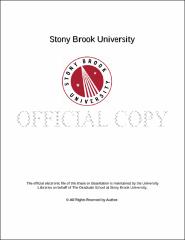| dc.identifier.uri | http://hdl.handle.net/11401/77766 | |
| dc.description.sponsorship | This work is sponsored by the Stony Brook University Graduate School in compliance with the requirements for completion of degree. | en_US |
| dc.format | Monograph | |
| dc.format.medium | Electronic Resource | en_US |
| dc.language.iso | en_US | |
| dc.publisher | The Graduate School, Stony Brook University: Stony Brook, NY. | |
| dc.type | Thesis | |
| dcterms.abstract | Food safety is a major concern in the shellfish industry, as severe illness can result from consuming shellfish that have accumulated waterborne pathogens. Shellfish harvesting areas are typically monitored for indicator bacteria such as fecal coliforms that serve as proxies for enteric pathogens introduced from surrounding waterways, but these indicators have shown little relation to some naturally occurring pathogenic bacteria such as Vibrio parahaemolyticus (Vp). To examine the dynamics and ecology of pathogenic and non-pathogenic strains of Vp and address the relevance of indicator bacteria in predicting Vp concentrations, field surveys and experiments were carried out in western Long Island Sound, NY, a region that has experienced recent outbreaks of shellfish contaminated with Vp. Pathogenic and non-pathogenic strains were quantified via PCR detection of marker genes and most probable number techniques. Field survey data showed little correspondence between fecal coliforms and Vp, but significant correlations between Vp and an alternative indicator, enterococci, as well as short-term (48 h) rainfall were observed. Experiments demonstrated that enrichment of seawater with phytoplankton-derived dissolved organic matter significantly increased the concentration of total Vp and the presence pathogenic Vp, but higher temperatures did not. Collectively, my thesis results suggest that fecal coliforms may fail to account for the full suite of important shellfish pathogens and that enterococci could provide a potential alternative or supplement to shellfish sanitation monitoring. Given the ability of algal-derived dissolved organic matter to promote the growth of pathogenic Vp, my results suggest that restricting nutrient inputs into coastal water bodies, which promote primary production and have detrimental secondary effects such as hypoxia, may additionally decrease the proliferation of Vp. As molecular detection methods for Vp and other pathogens are refined, monitoring efforts may be refined to more closely target specific pathogens of concern to protect human health. | |
| dcterms.available | 2017-09-20T16:53:32Z | |
| dcterms.contributor | Gobler, Christopher J | en_US |
| dcterms.contributor | Taylor, Gordon T | en_US |
| dcterms.contributor | Allam, Bassem. | en_US |
| dcterms.creator | Thickman, Jake | |
| dcterms.dateAccepted | 2017-09-20T16:53:32Z | |
| dcterms.dateSubmitted | 2017-09-20T16:53:32Z | |
| dcterms.description | Department of Marine and Atmospheric Science | en_US |
| dcterms.extent | 41 pg. | en_US |
| dcterms.format | Monograph | |
| dcterms.format | Application/PDF | en_US |
| dcterms.identifier | http://hdl.handle.net/11401/77766 | |
| dcterms.issued | 2016-12-01 | |
| dcterms.language | en_US | |
| dcterms.provenance | Made available in DSpace on 2017-09-20T16:53:32Z (GMT). No. of bitstreams: 1
Thickman_grad.sunysb_0771M_13036.pdf: 921627 bytes, checksum: 016b5a1a0fd4ef0a3da60a27388815f4 (MD5)
Previous issue date: 1 | en |
| dcterms.publisher | The Graduate School, Stony Brook University: Stony Brook, NY. | |
| dcterms.subject | long island sound, shellfish, vibrio | |
| dcterms.subject | Environmental science -- Microbiology | |
| dcterms.title | Pathogenic and non-pathogenic strains of Vibrio parahaemolyticus in Long Island Sound: Biotic and abiotic factors promoting abundance | |
| dcterms.type | Thesis | |

